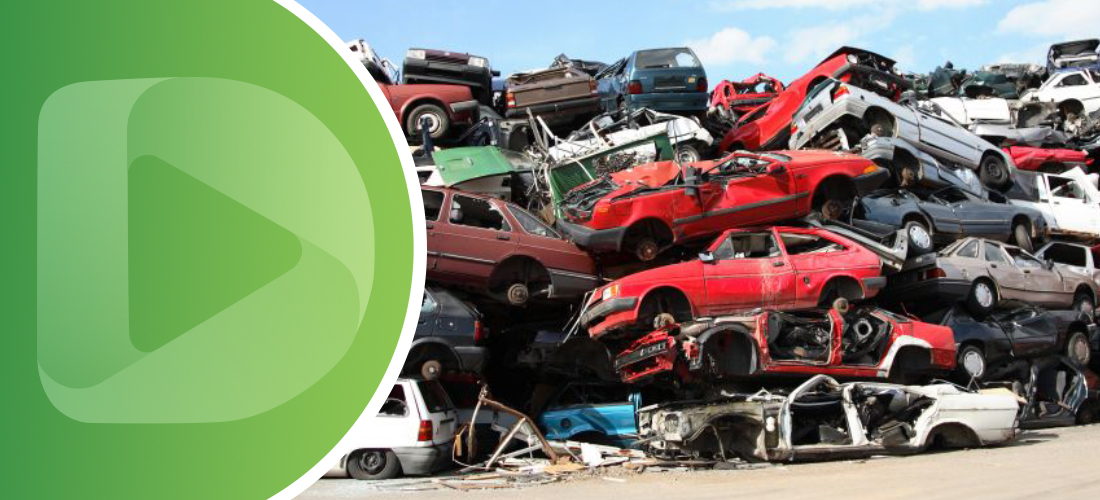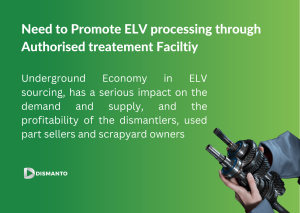Brewing Challenges of End-of-Life Vehicle Management (ELV)

| Read Time: 5 minutes
Impact of Sustainability on the State of the Automotive Industry
Today, technology is instrumental in radically changing the way various businesses operate. On the other hand, economies are also changing dramatically, with more sustainability-centric policies and digitization, resulting in the automation of processes and labor. Similarly, the Automotive domain is also moving towards a more sustainable approach. Primarily, because the Automotive industry is one of the largest sources of pollution in the environment. Also, research predicts that Automotive Industry will be vulnerable in 2023, due to the energy crisis and slow global demand, and disruptions in the global supply chain. These aspects will also have a direct impact on the Auto Recycling industry, we will explore the same in the context of End-of-Life Vehicle Management.
Presently, trends in the automotive industry for new vehicles are witnessing the adoption of autonomous driving, diverse mobility, connectivity, and sustainable solutions. Whereas, the second-hand vehicle market is also seeing a paradigm shift. Where Auto Recyclers from European and North American Countries are now focusing on and seeking advanced technology solutions to contribute to the Circular Economy Model through Recycling. Reusing. Reselling.
Let’s Explore the Key Challenges of End-of-Life Vehicle Management
Knowledge & Awareness Amongst Recyclers
The Auto Recycling industry usually has types of auto recyclers, and there is much that overlaps, considering the process of dismantling is extensive. Some auto recyclers see ELVs as a source of Second Hand Parts that can be reused or recovered. And others who use ELVs as a source of raw materials like metals and circular plastics. The latter, generally lack the know-how for recovering parts or plan to sell car parts. Also, the industry’s reputation is affected by issues with licensing and enforcement of laws and suffering from the brunt of the underground economy for used parts.
Many of these auto recycling facilities or Authorized Treatment Facilities are old businesses, therefore very conventional. Also, most decisions are based on manual operations, leading to inaccuracy in part valuation and car valuation, and resulting in disappointment at a profit level and also customer satisfaction level. At times, this is also due to less awareness of the market. And sometimes, the employees at these facilities lack the awareness to use technology to better their processes. Thereby, affecting the circular income flow.
Demand & Supply of ELVs Affecting Profit
For the Auto Recycling Industry, ELVs are a main source of raw materials and recycled auto parts and have a significant impact on the overall size of the Auto Recycling Market. The supply of ELVs is dependent on many factors, but not all attrition vehicles go for disassembly. Most ELVs are scrapped and directly sent to the Metal Recycling Industry or Other Auto Recyclers. Then, there are exports of ELVs and acquiring at auctions by Auto Recyclers.
It is known what ELVs acquired by Auto Recyclers are indirectly linked to the Auto Recycling Industry’s profit and available yard space. These ATFs or Recycling Centers get rid of older ELVs in order to free up space and acquire newer ELVs and manage space in their yards. This results in selling vehicles at a cheap cost and not extracting the true value of the used car or its used car parts which may have been profitable if managed better. Here, the demand for ELVs, driven by the number of Auto Recyclers is a major determinant for the ELV cost of purchase which in turn affects the industry profit.
More Scrapping than Recovery
Recovering a part from a used cars is rather more expensive and energy-intensive than scrapping the car. Usually, scrapping was preferred by many dismantlers up until now over recovering and reusing parts. So, it is safe to say that scrapping a car looked always easier and more profitable for a dismantler or an auto recycler. This often happens in case the facility has reached its maximum capacity for keeping ELVs.
However, with the recovery of used parts, reusing and recycling can be encouraged i.e., used parts selling, which will eventually take up less space in the yard. Also, over the years, we have seen a considerable rise in used part selling. But the challenge with recovery is not having the knowledge of which parts to extract from a car. Also, there is no structured way to decide which part to extract maybe partially, or consider the depreciating value of the parts in the car at the yard.
Decision Making based on Manual Parameters
Today, Auto Recyclers estimate vehicle parts value based on their understanding and experience with End-of-Life Vehicles and recycled auto parts. But that does not necessarily give them accurate pricing and value that can be fetched from a used car part or an entire used car. Because these decisions are usually on-the-go and also sometimes with the idea of freeing space in the yard, and that results in low-margin selling. This also becomes another reason for the problem with profitability in this industry. Because there is no standardized way to value your parts and end-of-life vehicle management.
Moreover, there is less insight into what parts can be recovered, without having to manually dismantle the car, which is a time and effort-taking process. “Objective Decision making based on analytics and insights can be the game changer for this industry,” says the Co-Founder of Dismanto, dismantling cars smartly.
“Objective Decision Making based on analytics and insights can be a game changer for the Valuation of Used Car Parts and Used Cars. It will enable ATFs to make their businesses profitable which is a challenge because most of their decision-making is based on manual parameters at the moment.”
Co-Founder – Indrajeet Mitra, Dismanto – A Gateway Group Co.
Yard Space Shortage
From our conversations and learnings from various dismantlers, we have developed this learning that many facilities suffer from premises management, and that stocking of ELVs and congestion management can be challenging.
Storage or (ELV) End-of-Life Vehicle Management requires space, and a separate warehouse is required for the storage of recovered vehicle parts. This results in dismantlers and disassemblers from scrapyards carrying large inventories for both ELVs and parts. They have to constantly adapt their facility size to maintain profitability, which means expanding their facilities but also shrinking which is highly dependent on the uncertain demand patterns of the ELV supply. This affects the industry’s turnover and maintaining profit is hindered. The industry’s reputation is affected drastically because of issues with licensing and enforcement.
Find out with our ELV experts, how you can combat these challenges at your Authorized Treatment Facility and improve End-of-Life Vehicle Management.

Energy Crisis & Climate Change – The Driving Forces of the Auto Recycling Market
In recent times, climate change and the energy crisis, have driven the Automotive Industry to take every step with sustainability in mind and choose a circular economy model. While we understand that the Automotive Industry is choosing to be more sustainable, Auto Recycling facilities are still struggling with the above-mentioned challenges. And some businesses are learning and using new-age methods and technologies to segregate material waste, treat residue and become more environmentally friendly. The concept of ‘Green Parts’ is picking up i.e. recovered used vehicle parts. Strategies to reduce CO2 emissions and landfills are being explored and discussed.
Europe, in particular, is going through some massive changes in policies and setting the bar for auto recycling worldwide, particularly France, the United Kingdom, Spain, and Italy. The End-of-Life Vehicles Directive was adopted by the European Commission in 1997 to tackle waste created by End-of-Life Vehicles (ELVs).
To take this Directive into account, many ATFs i.e., Authorized Treatment Facilities are investing in their processes and adhering to the EU guidelines for ELV i.e., End of Life Vehicle Processing. Here, reduced raw materials consumption, reduced energy consumption, reduction of CO2 emission, reduction of materials sent to landfill, creation of local and skilled jobs, and new manufacturing techniques are the driving factors of Auto Recycling.
Summing Up
The government and independent aftermarket are taking measures to combat climate change. And under the umbrella of the Automotive Industry, the idea of a circular economy is up to speed, and more businesses are now investing and preparing their strategies to be aligned with Auto Recycling.
Recycling auto parts and used cars is a flourishing avenue for Automotive Industry.
Stay tuned to learn more about Auto Recycling with the ELV experts from Team Dismanto.
Source Credit:

